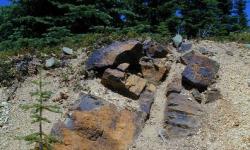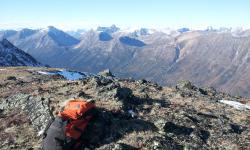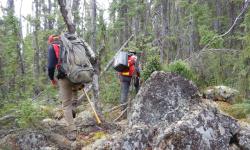Rockridge Resources Commences Winter Drilling Program at Eagle Plain’s Knife Lake Project, Northern Saskatchewan
Saskatchewan | March 19, 2019Cranbrook, B.C., March 19th, 2019: Eagle Plains Resources Ltd. (TSX-V: “EPL”) has received notice from Rockridge Resources Ltd. (TSX-V: ROCK) that it has commenced a winter diamond drilling program on the Knife Lake Property, owned 100% by Eagle Plains and under option to Rockridge. Winter drilling will consist of approximately 1,000m in eight to ten holes. The 85,196 ha Knife Lake claims cover both the historical Knife Lake VMS deposit and an extensive, under-explored regional VMS target area. The Knife Lake area saw extensive exploration from the late 1960’s to the 1990’s with the last documented work program completed in 2001.
To earn a 100% interest, Rockridge has agreed to make a cash payment to Eagle Plains of $150,000 upon regulatory approval (complete), issue up to 5,250,000 common shares of Rockridge (2M shares issued to date) and complete $3,250,000 in exploration expenditures over four years. Eagle Plains will retain a 2% net smelter royalty (“NSR”) on certain claims which comprise the project area. Under the terms of the agreement Rockridge is designated as the Operator of the project.
See Knife Lake regional map
The current drill program will focus on verifying the results of historic drilling as well as infill and step- out drilling to better define the Knife Lake mineralization. Results from this program will be used to support an updated NI 43-101 compliant resource calculation for the project.
Historical drill assays will be validated by twinning select historical drill holes targeting the higher grade core of the Knife Lake deposit. In 1998, Leader Mining published a historical estimate of the shallow VMS deposit, reporting a drill-indicated, non NI 43-101 compliant historical resource of 20.3 million tonnes grading 0.6% Cu, 0.1 g/t Au, 3.0 g/t Ag, 0.06% Co and 0.11% Zn. Leader also defined a higher grade zone of 11.0 million tonnes grading 0.95% Cu within this historical estimate.*
Additional drilling will focus on resource upgrade or expansion by infill drilling between historical holes, and drilling in areas with unverified or missing historical assays.
Knife Lake Geology and History
The Knife Lake deposit lies within the Scimitar Complex, which is believed to be the disconnected, northwest extension of the northern Flin Flon domain and the Amisk Volcanic package, which hosts massive sulphide mineralization in the Flin Flon–Snow Lake mining district, the most prolific greenstone belt in Canada. Since the initial discovery of mineralization in 1915, the Flin Flon camp has produced over 170 million tons of sulphide ore from 31 VMS deposits worth in excess of C25 billion dollars. (2002 NRC, Current Research). Exceptionally high Au contents of many of these deposits, including Flin Flon (62.4 Mt @ 2.6 g Au/t) and Lalor (8.8 Mt @ 4.6 g Au/t in the Au zone), make them particularly attractive exploration targets. This information is provided only as historical reference. Management cautions that past results or discoveries on proximate land are not necessarily indicative of the results that may be achieved on the subject properties.
Knife Lake is interpreted to be a remobilized VMS deposit. The stratabound mineralized zone is approximately 15 m thick and contains copper, silver, zinc and cobalt mineralization which dips 30° to 45° eastward over a strike-length of 4,500 m, with an average horizontal width of approximately 300 m. The deposit is hosted by felsic to intermediate volcanic and volcaniclastic rocks which have been metamorphosed to upper amphibolite facies. The deposit is typical of VMS mineralogy which has been significantly modified and partially remobilized during the emplacement of granitic rocks. The mineralization straddles the boundary between two rock units and occurs on both limbs of an overturned local fold.
Drilling has outlined a series of stratabound ore lenses which are controlled by complex geological structures. In the copper mineralized zone, significant thickening of the mineralization occurs near the central portion of the deposit. Sulphides and rare native copper are visible in outcrop. Massive sulphides consist of 25 to 60% pyrrhotite and 0.2 to 10% chalcopyrite mineralization. Pyrite is present as irregular disseminations and masses. Locally, up to 8% sphalerite (zinc mineralization) is present.
The first documented work in the Knife Lake showing area occurred between 1969-1973, consisting of ground and airborne geophysical surveys and extensive soil geochemical sampling. The discovery drill-hole, collared in September, 1969, returned 2.37% Cu over 4.48m from 19.96-24.44m, including 3.5% Cu over 2.5m from 20.27-22.77m. A total of 96 diamond drill holes (8,232m) were completed between 1969-1971 and in 1973 Straus Exploration announced a maiden resource on the Knife Lake Deposit.
Hudson’s Bay Exploration and Development Company Ltd. later carried out a regional Airborne EM geophysical survey in the Knife Lake – Scimitar Lake area, followed up by geological mapping, prospecting, ground geophysics and diamond drilling. The property was subsequently optioned by Copperquest Incorporated in 1989, which carried out further geophysical and geochemical surveys and optioned the property to Leader Mining International in 1996. Between 1996 and 2001, Leader flew various airborne geophysical surveys in the area, including EM, magnetic, and gravity surveys. This was followed up with stripping and trenching of the outcropping deposit area. Ground TEM, magnetic, ground IP/Resistivity and VLF-EM surveys were completed over and adjacent to the main deposit area.
Between 1996 and 1998, Leader completed 315 drill holes, outlining a broad zone of mineralization occurring at less than 100 meters depth (AF 63M-0006, Report 10). Late in 1998, Leader published the geological reserves of the deposit, reporting a drill-indicated resource of 20.3 million tonnes grading 0.6% Cu, 0.1 g/t Au, 3.0 g/t Ag, 0.06% Co and 0.11% Zn. It was suggested that 11.0 million tonnes grading 0.95% Cu could be mined using an open pit (SMDI 0406).
*Eagle Plains’ management considers these estimates to be historical in nature and cautions that a Qualified Person has not done sufficient work to classify the historical estimates as current mineral resources or mineral reserves in accordance with National Instrument 43-101. These estimates do not comply with current definitions prescribed by National Instrument 43-101 or the Canadian Institute of Mining, and are disclosed only as indications of the presence of mineralization and are considered to be a guide for additional work. The historical models and data sets used to prepare these historical estimates are not available to Eagle Plains, nor are any more recent resource estimates or drill information on the Property.
A 357kV powerline has recently been completed to within 16km of the Knife Lake Deposit area, greatly enhancing the project’s infrastructure
Charles C. Downie, P.Geo., a “Qualified Person” for the purposes of National Instrument 43-101 - Standards of Disclosure for Mineral Projects and a Director of Eagle Plains, has prepared, reviewed, and approved the scientific and technical disclosure in the news release.
About Eagle Plains Resources
Based in Cranbrook, B.C., Eagle Plains continues to conduct research, acquire and explore mineral projects throughout western Canada. The Company is committed to steadily enhancing shareholder value by advancing our diverse portfolio of projects toward discovery through collaborative partnerships and development of a highly experienced technical team. Managements’ current focus is to preserve its treasury while advancing its most promising exploration projects. In addition, Eagle Plains continues to seek out and secure high-quality, unencumbered projects through research, staking and strategic acquisitions. Since 2012, Eagle Plains has added to its portfolio a number of new projects exceeding 130,000 ha targeting mainly gold, uranium and base-metals in Saskatchewan, a highly-prospective mining jurisdiction which was recently recognized by the Fraser Institute as the second best place in the world in terms of Investment Attractiveness. Throughout the exploration process, our mission is to help maintain prosperous communities by exploring for and discovering resource opportunities while building lasting relationships through honest and respectful business practices.
Expenditures from 2011-2018 on Eagle Plains-related projects exceed $20M, most of which was funded by third-party partners. This exploration work resulted in approximately 30,000 m of diamond-drilling and extensive ground-based exploration work facilitating the advancement of numerous projects at various stages of development
On behalf of the Board of Directors
“Tim J. Termuende”
President and CEO
For further information on EPL, please contact Mike Labach at 1 866 HUNT ORE (486 8673)
Email: mgl@eagleplains.com or visit our website at https://www.eagleplains.com
Cautionary Note Regarding Forward-Looking Statements
Neither the TSX Venture Exchange nor its Regulation Services Provider (as that term is defined in the policies of the TSX Venture Exchange) accepts responsibility for the adequacy or accuracy of this release. This news release may contain forward-looking statements including but not limited to comments regarding the timing and content of upcoming work programs, geological interpretations, receipt of property titles, potential mineral recovery processes, etc. Forward-looking statements address future events and conditions and therefore, involve inherent risks and uncertainties. Actual results may differ materially from those currently anticipated in such statements.
Latest News Releases

Eagle Plains Resources and SKRR Exploration Provide Update on the Olson Gold Project

Eagle Plains Partner Earthwise Completes Data Review of the Iron Range Gold Project, British Columbia

Eagle Plains and Sun Summit Minerals Execute Option Agreement for the Theory Copper-Gold Project, British Columbia

Eagle Plains and Earthwise Minerals Execute Option Agreement for the Iron Range Gold Project, British Columbia

Eagle Plains and Partner Refined Energy Receive Permit for Drilling at Dufferin West Uranium Property, Saskatchewan

